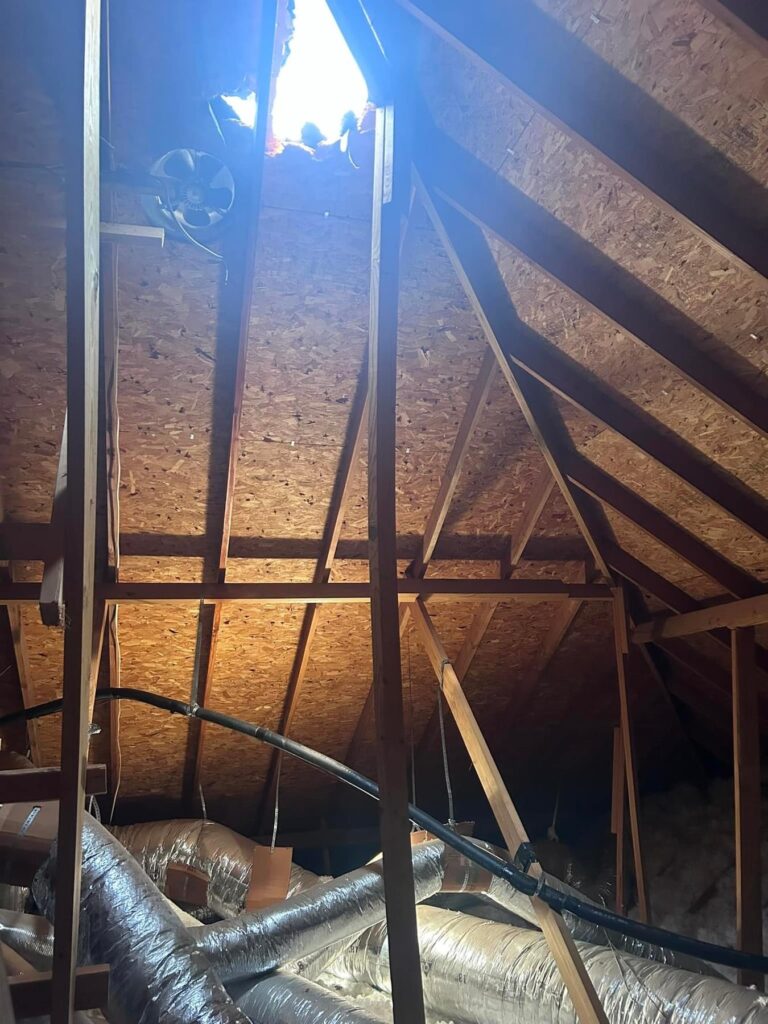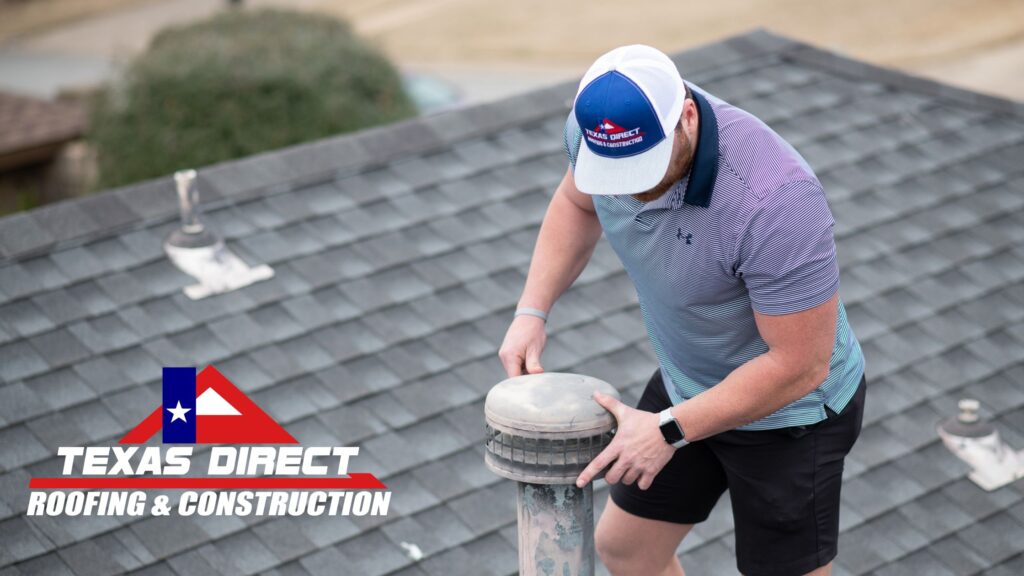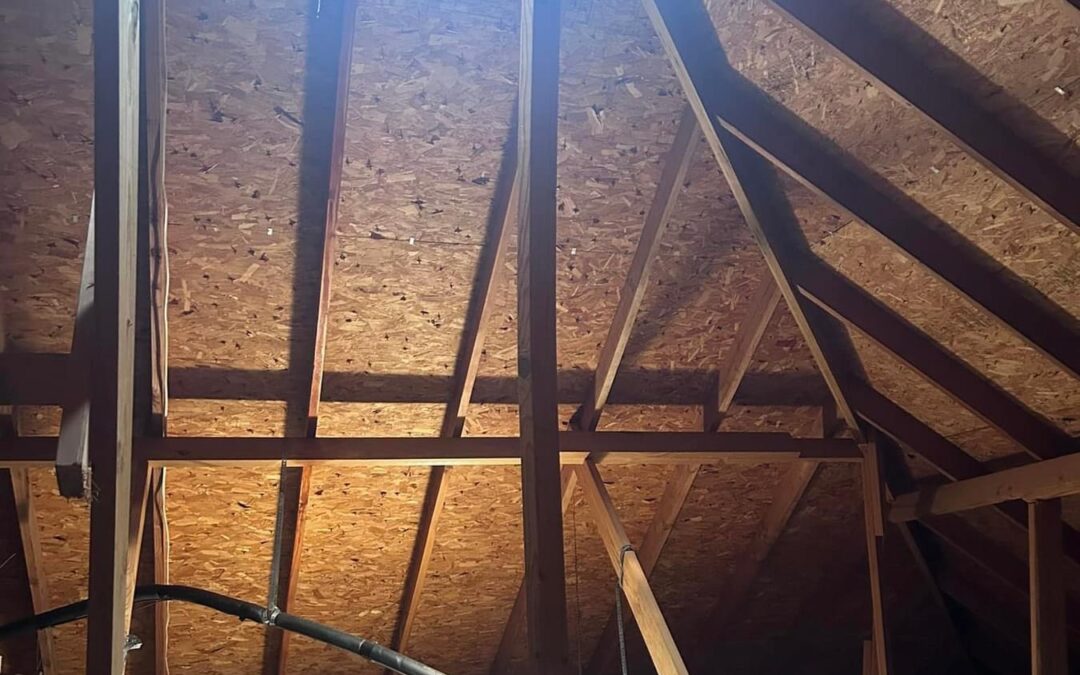A lightning bolt is gorgeous, but it’s also terrifying. With millions of volts of electricity surging through the sky, the shock waves from a lightning strike can have terrible effects. Homes are vulnerable to a lightning bolt, especially the roof, which is often the first point of contact. Understanding what happens when lightning strikes a roof can help you take the right steps to protect your property and respond effectively if a strike causes roof damage.
Before we do, why is a roofing company like us writing about this electric topic? Recently, a client came to us for a roof inspection after lightning blew a hole in the roof and sent a surge through their electrical wiring. You could see right through their roof shingles, thanks to the lightning damage. They needed help navigating the claim with their insurance company and deciding whether to file for electrical damage or severe damage to the roof itself. You can see more details about their project in the video below…
How Lightning Strikes a Roof
Lightning strikes happen when static electricity builds up in storm clouds. As this becomes more intense, it tries to balance itself by connecting with the ground, resulting in a lightning strike. Anything tall, like homes, trees, and even people, can become the conductive path for this powerful, explosive surge.
Did you know that the materials that make up a roof can influence whether it’s likely to attract lightning? Metal roofs, for example, might seem more prone to getting nailed by a bolt of lightning due to their conductive properties, but in reality, any roof can be struck. Our clients had a standard asphalt shingle, and still received a direct strike. Electrical systems, metal pipes, and other conductive materials inside a home can also attract lightning.

Immediate Effects of a Lightning Strike
When lightning strikes a roof, the effects can be immediate and severe. The electrical surge from the strike is potent, causing direct and secondary damage to your entire house.
Direct Damage:
The most immediate impact of a lightning strike on a roof is physical damage. Shingles can crack, warp, or, in the case of our client, be blown off entirely by the force of the strike. In some cases, the intense heat can cause charring or even start a fire. The roof’s underlying structure, including trusses, beams, and supports, may also suffer significant damage. The lightning current from the strike can cause wooden structures to splinter or weaken, compromising the roof’s integrity.

Secondary Damage:
Beyond the direct impact, lightning strikes often result in secondary damage. One of the most common issues is fire. Roofing materials or certain types of insulation can ignite from the extreme heat, leading to a fire that can spread quickly through the home. Additionally, lightning can cause power surges that damage the home’s electrical system, leading to blown fuses, damaged appliances, and even electrical fires. These surges can travel through the wiring in the home, affecting anything that’s plugged in or even light switches.
Signs That Your Roof Has Been Struck by Lightning
Not all strikes are immediately apparent, especially if they don’t cause a fire. However, several signs can indicate a roof has been struck by lightning.
Visible Damage:
The most obvious signs of a lightning strike are damage to the roof. This can include missing or damaged shingles, holes in the roof, or burn marks on the shingles or other roofing materials. In severe cases, you might see parts of the roof that the force of the strike has completely blown apart.
Interior Indicators:
Inside the home, there can be other signs that lightning has struck. These include burn marks on walls or ceilings, the smell of smoke, or visible electrical damage like scorched outlets. You might also notice that certain appliances or electronic devices no longer work, which could indicate a power surge caused by a lightning strike.
Subtle Signs:
Some signs of a lightning strike might take time to be apparent. For example, a roof leak that develops shortly after a storm could result from damage caused by a lightning strike. This is especially likely if there are no other apparent signs of damage. In such cases, it’s essential to have a professional inspect the roof to determine the cause of the leak and assess any potential hidden damage.

Steps to Take After a Lightning Strike
If your home is struck by lightning, it’s crucial to act quickly to minimize damage and ensure the safety of everyone inside.
Immediate Safety Measures:
The first step is to ensure that everyone is safe. If there’s any sign of fire or significant structural damage, evacuate the home immediately and contact emergency services. Even if the damage appears minor, staying out of the home is wise until a professional has inspected it. It’s also a good idea to have your local fire department come give the home a good once-over, to make sure it’s safe from a fire.
Assessment and Inspection:
Once it’s safe, the next step is to assess the damage. It’s vital to hire a professional roofing contractor to inspect the roof and other affected areas thoroughly. Companies like us, Texas Direct Roofing & Construction, will be able to identify visible and hidden damage, ensuring all issues are addressed. Documenting the damage with photos and notes is also a good idea, as this information will be crucial when filing an insurance claim. Since we’re a general contractor with years of experience, we’ll also assess the general state of your home, including the electrical system.

Repairs and Restoration:
Depending on the extent of the damage, you may need to take immediate steps to prevent further issues. This might involve temporary repairs, like covering damaged areas with tarps to prevent water intrusion. Once the initial emergency is handled, you can work with your roofing contractor to develop a plan for permanent repairs or roof replacement if necessary.
Preventing Lightning Damage to Your Roof
While it’s impossible to prevent lightning strikes completely, there are steps you can take to minimize the risk and protect your home.
Lightning Rods and Grounding Systems:
Installing a lightning protection system is one of the most effective ways to protect your home from lightning. This typically includes lightning rods, designed to attract lightning and direct it safely to the ground, away from your home’s structure. A grounding system ensures that the electrical energy is safely dissipated into the earth, reducing the risk of fire or structural damage.
Regular Maintenance:
Keeping your roof in good condition can also help it withstand the effects of a lightning strike. Regular inspections and maintenance can identify and address potential weak points in the roof, such as damaged shingles or deteriorating flashing, before they become more significant problems. Ensuring your home’s electrical system is up to code and properly grounded can reduce the risk of lightning-related damage.
Insurance Considerations:
Finally, make sure your homeowners’ insurance policy covers lightning damage. Review your policy and consider adding additional coverage if necessary. In the event of a lightning strike, having the right insurance can significantly improve your ability to recover from the damage.
Conclusion
A lightning strike is a powerful and potentially destructive force, mainly when it targets your home. Understanding the effects of a lightning strike on your roof and knowing the steps to take in the aftermath can help you protect your property and ensure your family’s safety. By taking preventive measures like installing a lightning protection system and maintaining your roof, you can reduce the risk of damage and be better prepared to handle the unexpected.
If you’re concerned about potential lightning damage to your roof, contact us today to schedule a professional inspection. Our expert roofing contractors can assess your home’s risk and recommend the best solutions to keep your property safe. Don’t wait until it’s too late—take action now to protect your home from the next storm.


